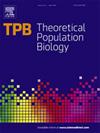The distribution of the number of mutations in the genealogy of a sample from a single population
IF 1.3
4区 生物学
Q4 ECOLOGY
引用次数: 0
Abstract
The number of mutations in the genealogy of a sample of sequences from a single population is one essential summary statistic in molecular population genetics and is equal to the number of segregating sites in the sample under the infinite-sites model. Although its expectation and variance are the most widely utilized properties, its sampling formula (i.e., probability distribution) is the foundation for all explorations related to K. Despite existence of an analytic sampling formula, its numerical application is limited due to susceptibility to error propagation. This paper presents a new sampling formula for in a random sample of DNA sequences from a neutral locus without recombination, taken from a single population evolving according to the Wright–Fisher model with a constant effective population size, or the constant-in-state model, which allows the effective population size to vary across different coalescent states. The new sampling formula is expressed as the sum of the probabilities of the various ways mutations can manifest in the sample genealogy and achieves simplicity by partitioning mutations into hypothetical atomic clusters that cannot be further divided. Under the Wright–Fisher model with a constant effective population size, the new sampling formula is closely analogous to the celebrated Ewens’ sampling formula for the number of distinct alleles in a sample. Numerical computation using the new sampling formula is accurate and is limited only by the burden of enumerating a large number of partitions of a large K. However, significant improvement in efficiency can be achieved by prioritizing the enumeration of partitions with a large number of parts.
突变数:来自单一种群的一个样本的家谱中突变数的分布
在分子群体遗传学中,单个群体的n个序列样本的家谱突变数K是一个重要的汇总统计量,在无限位点模型下等于样本中的分离位点数。虽然它的期望和方差是最广泛使用的性质,但它的抽样公式(即概率分布)是所有与k相关的探索的基础。尽管存在解析抽样公式,但由于易受误差传播的影响,其数值应用受到限制。根据Wright-Fisher模型(有效群体规模恒定)或恒态模型(允许有效群体规模在不同的聚合状态下变化),从一个无重组的中性位点DNA序列的随机样本中,提出了一个新的K抽样公式。新的抽样公式表示为突变在样本谱系中表现的各种方式的概率之和,并通过将突变划分为不能进一步划分的假想原子簇来实现简单性。在有效群体大小不变的Wright-Fisher模型下,新的抽样公式与著名的evens样本中不同等位基因数量的抽样公式非常相似。使用新抽样公式的数值计算是准确的,并且仅受枚举大k的大量分区的负担的限制。然而,通过优先枚举具有大量零件的分区可以显着提高效率。
本文章由计算机程序翻译,如有差异,请以英文原文为准。
求助全文
约1分钟内获得全文
求助全文
来源期刊

Theoretical Population Biology
生物-进化生物学
CiteScore
2.50
自引率
14.30%
发文量
43
审稿时长
6-12 weeks
期刊介绍:
An interdisciplinary journal, Theoretical Population Biology presents articles on theoretical aspects of the biology of populations, particularly in the areas of demography, ecology, epidemiology, evolution, and genetics. Emphasis is on the development of mathematical theory and models that enhance the understanding of biological phenomena.
Articles highlight the motivation and significance of the work for advancing progress in biology, relying on a substantial mathematical effort to obtain biological insight. The journal also presents empirical results and computational and statistical methods directly impinging on theoretical problems in population biology.
 求助内容:
求助内容: 应助结果提醒方式:
应助结果提醒方式:


